
| Go to Allan's Page | Our Home Page | Holidays Home Page | British Canals Page | Go to Deb's Page |
| FlickR album of these photos | The other 3-legged island - Mann |
For many years we had promised ourselves a visit to Sicily - partly because we love their wines so much - and finally in 2023 we decided to go there for my birthday, and booked it through Titan Travel. As well as its food and wines, of course, Sicily is known for its Mediterranean climate and for its wealth of historical architecture - particularly from when the Greeks occupied the island and from when the Romans conquered it (note the difference in terminology there). We were eagerly looking forward to sampling them all.
A few weeks before we were due to depart, our chances of taking the trip looked unlikely after an eruption of Mount Etna closed down much of the island including the airport but, with just a few days to spare, the airport was re-opened and we were on our way to the Land of Figs and Olives (that is what 'Sicily' actually means).
The coach met us at Catania airport and took us to the beautiful Hotel Politi at Syracuse. Built 160 years ago for the Sicilian painter Salvatore Politi and his wife (who was an Austrian noblewoman) this magnificent building has a fabulous garden with many magnificent statues. The hotel's impressive history includes having been used by Winston Churchill during the allied invasion of Italy as well as having on occasions been a meeting place for Kings, Princes, presidents, prime ministers, and Popes from all over Europe. We were extremely pleased with our large high-level room, which had an excellent view across the city through the unusual oval window of its balcony. It was quite late in the evening so we strolled down the road to a nearby bar, and sat happily on their terrace enjoying a delicious glass of local wine while watching a fireworks display which was taking place down at the harbour; it made a magical atmosphere in which to start our holiday.
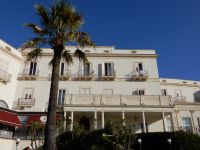 |
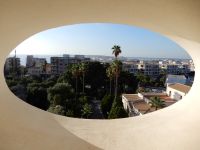 |
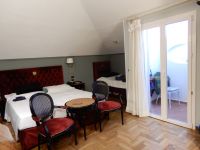 |
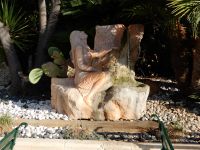 |
The beautiful Hotel (see the oval windows on the top floor) |
The view through our balcony's oval window |
Our room was excellent |
One of the many statues in the garden |
The next day we visited the local Roman amphitheatre, including the orchards and quarries where the slaves were employed. We made a brief stop at the Ear of Dionysius, a strange ear-shaped cave beneath the amphitheatre which had the most incredible echo and acoustics. The site was already important before the arrival of the Romans: it has the largest Greek altar in the world, at which thousands of animals were ritually slaughtered (the meat was then used to provide a feast, so it was not wasted)
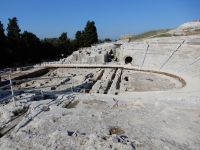 |
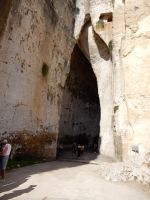 |
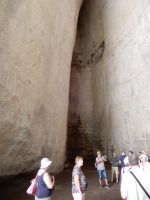 |
 |
The Roman amphitheatre of Syracuse |
The Ear of Dionysius cave. |
The Greek altar behind Debbie is over 200 yards long |
|
We then went to the nearby island of Ortigia, where the original city of Syracuse was located, passing a statue of Archimedes (who was one one of its early residents) as we walked across the 16th century bridge. We were given a guided tour of the narrow streets, passing beautiful medieval buildings including the cathedral at the town square
After a leisurely stroll around Ortigia and a delicious lunch of locally-caught seafood in a small cafe (with of course a glass or two of the local wine) we were treated to a round-the-island boat trip.
 |
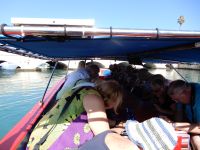 |
 |
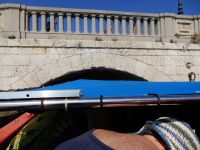 |
We've got to get under that low bridge |
You'll have to duck, we need to put the roof down |
No, that's not enough. I meant RIGHT DOWN |
Yes I think we should just fit now |
After the boat trip we returned to the Hotel Politi for dinner and a leisurely evening, followed by a rather short night's sleep after Debbie accidentally set our clock to a sort of 'Double-European' time which meant that we were up very early in the morning. At least it gave me plenty of time before breakfast to open my birthday cards and presents!
That day our coach took us to several hilltop towns; the first of these was called Noto. We strolled through the town, enjoying the sunshine and the beautiful baroque buildings, and then we spotted signs to an art exhibition which looked rather interesting.
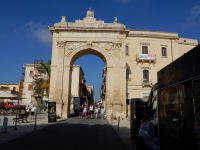 |
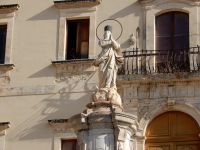 |
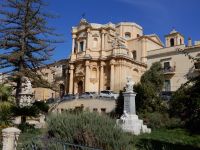 |
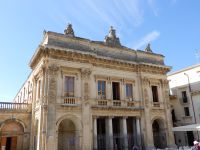 |
The entrance gate to the town of Noto |
Noto has some wonderful statues ... |
... and many amazing buildings ... |
|
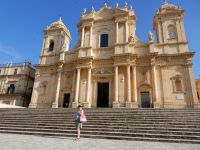 |
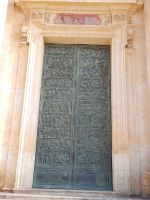 |
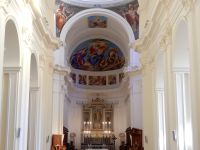 |
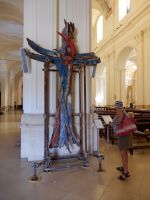 |
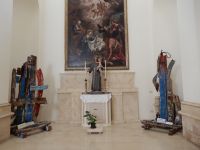 |
... including a fabulous cathedral ... |
... whose door tells many biblical tales |
The interior of the cathedral is beautiful |
Some of the modern artwork inside the cathedral is actually quite disturbing |
|
We were so glad that we visited the exhibition. The art gallery was just wonderful, and although we were not so impressed by the modern sculpture section, the 'Pop-Garden' experience room was just mind-blowing!
Leaving Noto, the coach took us to Ragusa (where we had a fantastic lunch) and onwards to Modica. Here we climbed a very long steep stairway to visit a chocolate-maker for a tasting experience; I was not particularly impressed by the visit which was actually little more than a sales-pitch, whereas Debbie simply took a bus-tour of the town and had a very enjoyable time.
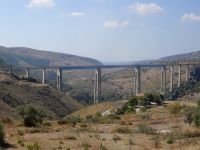 |
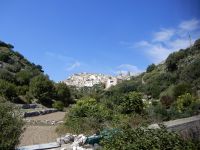 |
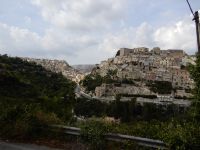 |
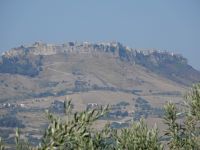 |
The scenery was amazing, with spectacular roads passing many hilltop towns |
|||
That night, to celebrate my birthday, we had a special meal in the hotel's dining room. It was simply marvellous! Then the following morning we were on the coach immediately after breakfast, all packed up and ready to move to our next hotel which was on the outskirts of Palermo the capital of Sicily. On the way we visited the fortress city of Enna, where we greatly admired the hilltop cathedral, followed by the seaside town of Cefalu. Here we just strolled through the town and sat outside a cafe in the town square for a delicious lunch.
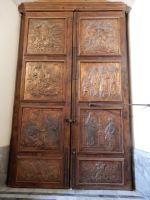 |
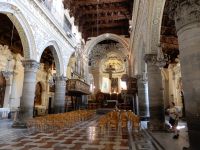 |
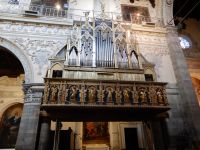 |
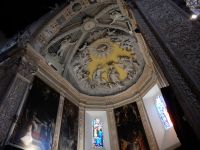 |
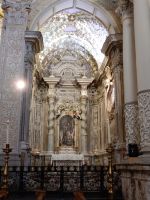 |
Another spectacularly beautiful Cathedral with biblical tales on the door, this time at the hilltop city of Enna |
||||
Later that afternoon we arrived at the Hotel Splendid La Torre, on the outskirts of Palermo. Although it was rated 4-star because of its facilities (including a private beach) we quickly nicknamed it 'Fawlty Towers'. Actually it was fine, apart from the chaotic check-in at reception, and the ultra-slow porterage, and the need to amend the dining times, and the lack of milk for the coffee, and all the drinks that the bar had sold out of, and the way they had printed the menus in German specially for us English guests, and the ultra-slow dinner service, and the air conditioning switch in our room being broken and stuck on 'extremely cold', and the utterly chaotic breakfast arrangements, and the lack of any hot water to the baths and showers in the rooms, and the way that when we asked for an ice-bucket for our wine at dinner, they brought us a saucer with 2 ice cubes, and ... (well I could go on but by now I expect you've got the picture)
Palermo was fascinating, and we enjoyed a detailed guided tour amongst its many styles of architecture which reflected its many occupiers including Arab, Turkish, Greek, Roman, and European. We learned about St Rosalia, who had lived as a hermit in a cave outside Palermo during the 12th century. When the city was struck by a plague in the 17th century, one citizen had a vision of her asking to be brought to down from the cave; he went to the place that the vision had described, and there he found her bones which he carried back to Palermo. Wherever he carried the bones, the plague disappeared, so she was venerated as the patron Saint of Palermo. The statue outside the Cathedral shows her victory over a (male) sailor because it was believed - probably correctly - that the plague was carried to the island by a visiting merchant ship.
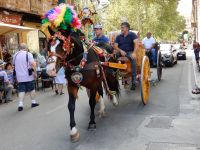 |
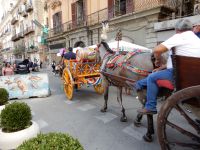 |
 |
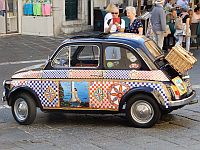 |
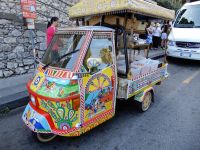 |
We saw many beautifully decorated traditional horse-drawn carriages ... |
... and some beautifully decorated carriages which were less traditional |
|||
After a short break for coffee and gelato, we walked to the nearby Palatine Chapel for a short tour.
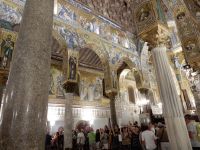 |
 |
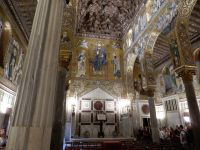 |
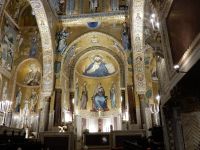 |
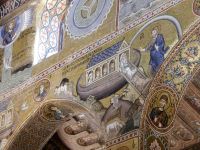 |
The spectacular interior of the Palatine Chapel in Palermo ... |
... including the story of Noah |
|||
The Palatine chapel in Palermo was indeed beautiful; however at nearby Monreale they were determined to build one that was bigger and even more beautiful. Well, you certainly cannot deny that it is bigger.
 |
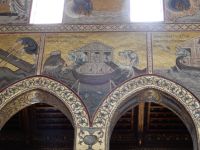 |
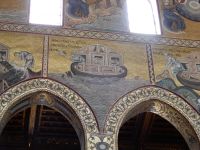 |
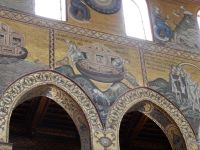 |
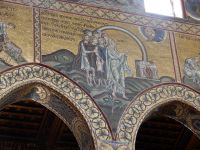 |
The wall friezes at Monreale Cathedral tell the story of Noah in great detail |
||||
Back at Fawlty Towers, Debbie actually went for a swim in the warm waters of the Mediterranean Sea. Then again the following morning we packed our cases and embarked on another coach trip. After a brief stop at the ancient salt pans of Trapani we drove back up into the hills to visit the town of Erice for lunch.
For the afternoon we visited the remains of Selinunte, which was once a huge Greek city. I find myself questioning, from an archaeological point of view, is it right to reconstruct the temples from the piles of stones that are lying all around (as they have done there) or to leave them undisturbed (as they have done at the Valley of the Temples which we visited the next day)?
We spent the next night at a fantastic hotel (the Baia di Ulisse) in Agrigento. What a contrast from our previous two nights!
The next morning we went to the Valley of the Temples, where the impressive ruins are in fantastically good condition. We very much enjoyed our guided visit, not least because the coach dropped us at the top of the valley and collected us from the lower end so we didn't have to climb back up the hill in the blazing hot sun. We were then taken to a Countess's country estate for a wonderful lunch before continuing to the Roman Villa del Casale which is justifiably famous for its amazing mosaic floors.
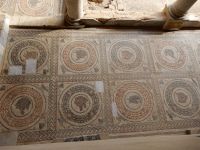 |
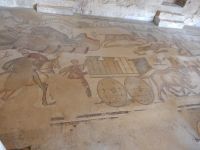 |
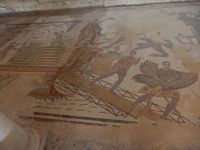 |
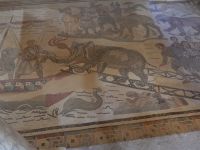 |
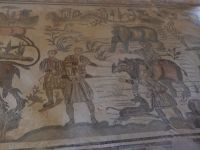 |
Illustrating the exotic animals they hoped to capture |
Setting off on the expedition |
Capturing an ostrich ... |
... and an elephant ... |
... and a rhinocerosle |
That night's hotel was just superb in every way. Our lovely double-aspect room looked out over the beautiful gardens in one direction and up to Mount Etna in the other. Full marks to the St Alphio Garden hotel at Giardini Naxos! The following day was very relaxing, strolling around the town of Taormina with an excellent guide before having a wonderful lunch at a busy little cafe, then returning to the hotel for a gentle swim in their pool and a few drinks at their poolside bar before an excellent meal in their restaurant. Just what we needed to build up our strength for the following day's activities!
The final day of our holiday was the climax of our visit to the island, with an expedition up its active volcano, Mount Etna. The coach zig-zagged its way up the approach road to a height of just over 6000 feet, at which point we were given our tickets for the cable-car which would take us up another 2000 feet. The views from the car were superb, and then we disembarked to transfer to the bus which would take us to meet our guide at an altitude of 9500 feet. As we got out of the bus we were very glad that we were wearing our warmest clothing; it had been 30 degrees Celsius at the hotel, it was around 30 degrees Fahrenheit near the mountain-top.
The guide led us up the steep track past a rocky gully which he told us was actually just a thin crust of solidified lave with a stream of molten lave running below it (so it was a very good idea to stay on the marked track!). He took us up to about 9800 feet, at which point the steam from the volcano turned and blocked our view; it was time to return
Finally - after a stop for a great lunch at a local winery - we returned first to the hotel and then, the next day, to England.
Arrivederci Sicilia!
| FlickR album of these photos | The other 3-legged island - Mann | |||
| Go to Allan's Page | Our Home Page | Holidays Home Page | British Canals Page | Go to Deb's Page |
All pictures on this site are © Allan Jones unless otherwise stated